Not too long ago, when I was doing woodwork at home, I saw some ugly wood fissure on the walls of my house.
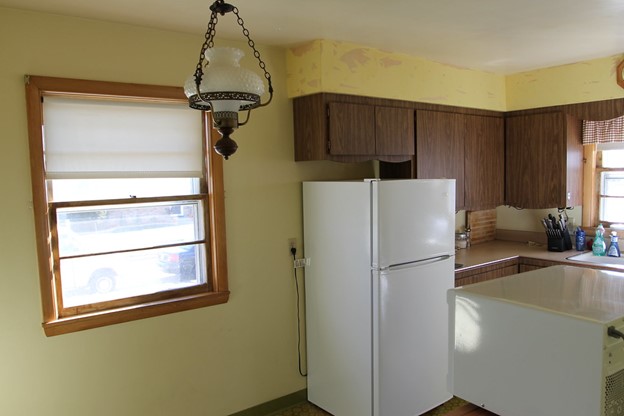
As I was trying to replace the wood, I discovered that it was only the tip of the iceberg; there was a whole kingdom of wood-decaying fungus at the back of the wall.
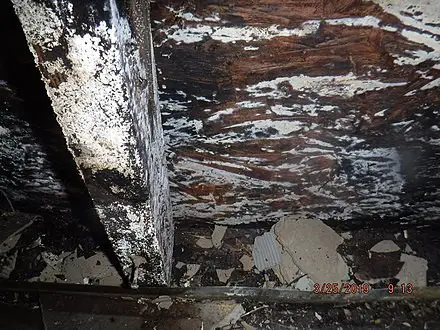
It was truly terrifying to see the damage that had already occurred, and I imagined what would happen if I hadn’t noticed for a few more months (my home could easily have been destroyed by now).
Now, the real question is how to get rid of wood decay fungus?
Applying a fungicide or anti-fungus agent (Borate) is the simplest way to get rid of the wood-decaying fungus.
The good thing is, there are two kinds of fungicide available: the first kind of fungicide is supplied to professionals for use over a large area. The second one is ready-to-use products that can be applied with a brush or low-pressure sprayer. This one is perfect for beginners who prefer a simpler process.
Well, it was a piece of cake for me, but I kept asking myself: What is causing all those problems? I got out of my chair and started researching the culprit. I discovered that there are different types of wood decay fungi. Each of them requires a different treatment method.
Different Types of Fungal Decay and Their Cure
Wet rot and dry rot are the most common types of wood rot. Both are caused by mold and fungus that attacks the wood on a microscopic level. Though both are destructive to wood, they each damage wood in unique ways.
Wet Rot
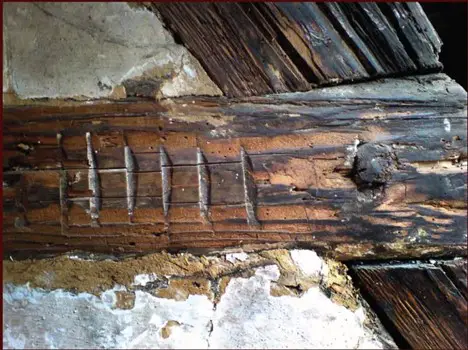
Image Source – https://commons.wikimedia.org/
In short, wet rot refers to wood decay caused by the presence of too much moisture. The fungi feed off the nutrients in damp timber (decks, around windows, etc.), plaster, wallpaper, and carpets. It breaks down the wood’s cell walls and causes it to fall apart.
When the moisture content of wood is above 20 percent, wet rot can start to grow. If the moist timber is not treated, it can cause the structural failure of buildings.
Treatment of Wet Rot
The cost of any repair or remediation depends on the extent of the damage to the wood. If rot is spread widely, you will have to replace parts of the structure, which can be costly.
The primary concern for wet rot is locating and eliminating the source of moisture: any leakage. Water damage can be expensive, especially if you need to replace your roof or repair a leaking pipe.
Once you have identified the source of moisture and eliminated it, apply fungicide to prevent the problem from recurring. In most cases, this treatment stops wet rot, and you can save those costly repairs.
You can also buy wood hardener, which works by soaking into the wood and strengthening it. This product is best for door frames and window shutters.
Dry Rot
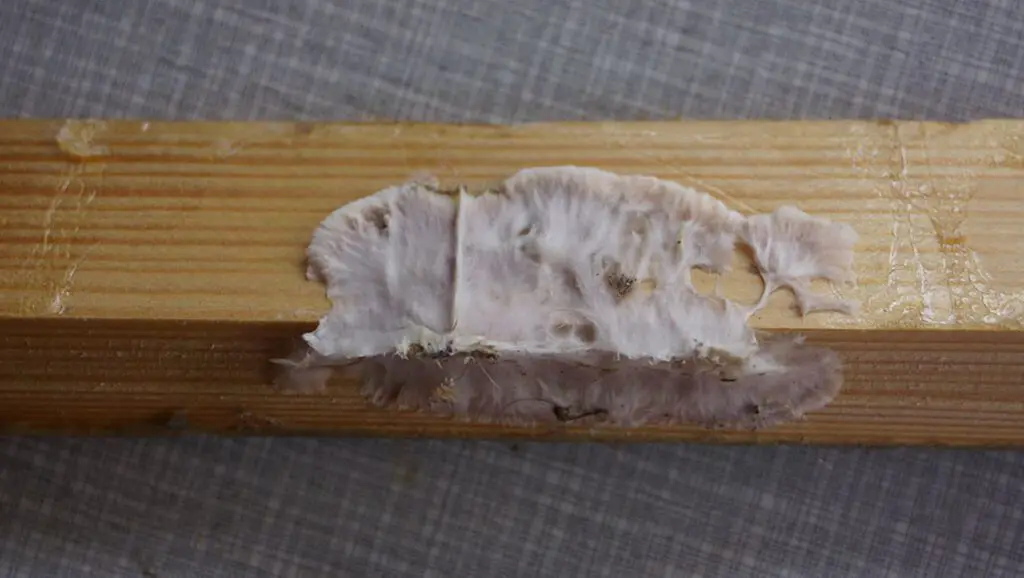
Image Source – https://upload.wikimedia.org/
Dry rot is a form of fungal decay that attacks wood inside buildings. It turns the wood a brownish-black color as the fungi target cellulose in the wood’s structure. But often, it appears as if the wood were dry because they attack it from the inside.
Treatment of Dry Rot
Dry rot is a serious issue, but it can be controlled using simple and affordable methods.
Like wet rot, dry rot begins with moisture. So, the first step to treating dry rot is locating the moisture source and fixing it.
You will then have to determine if it is limited to a single wall or if it has spread throughout the structure. To do this, you need to remove the plaster and render in all directions, as well as remove the flooring and lifting floorboards. Once you have done that, you can identify the infected timbers.
After finding the infected timbers, you will need to cut them back at least 500 millimeters where the fungal strands were first sighted.
Now, you’ll need to remove the fruiting bodies along with any visible spores. Clean the entire area to remove surface growth (hyphae, mycelium, and fruiting bodies). Use a stiff brush if necessary.
Then replace the timber with pre-treated timber. Use new or old sound timbers to reinforce the structure if it is necessary to strip out the old timber. Once this has been done, liberally treat the remaining sound timbers with a dual-purpose dry rot treatment fluid. This will kill dry rot and stop further outbreaks of this destructive fungus.
How Can I Identify Which Rot Has Invaded My Wooden Items?
Wet rot will give you the following signs:
- A smell of dampness, mildew, and decay
- Cracked and softer-than-usual wood
- Timber that has become discolored or is weak
- A floorboard that creaks when you walk over it
- Fungal growth that develops in a particular area
In case of dry rots, you will find the following signs:
- Timber splitting and cracking into small cubes
- Darker wood (often black)
- Wood that is dry or crumbly
- Fine and white looking mycelium
- Grey-whitish “skin.”
- A soft, squishy mushroom-like body with a pancake-like appearance.
- Spore-spreading red dust
How Can I Prevent Wood-decaying Fungi?
Fungus thrives in moisture. The first step in getting rid of mold and fungus is to find the source of moisture and eliminate it.
If you have a leaky roof, fix it. If you live in a humid climate, install strong air conditioning. Fix any problem in your home that might cause water to pool up or leak; otherwise, mold will only keep growing and ruining your possessions.
What Are the Most Common Places to Find Wood Rot at Home?
Some common locations where it can be found include:
- Under sinks
- Decks
- Window frames
- Door frames
- Basements
- Steps or stoops
- Siding or paneling
- Fences
- Threshold
- And the places where moisture content is more than 20%
This article may help you find places where rotting wood may be hiding in your home.
Are Wood Rots and Mold the Same Thing?
Mold looks different from wood rot. Mold is a discoloration, while wood rot is a breakdown or decay of the wood.
But, since both can thrive in damp or humid environments, the presence of mold could indicate that wood rot isn’t far behind.
What Does Wood Destroying Fungus Look Like?
Some wood decay fungi are easy to spot because of their unique appearance. The fruiting bodies they form on wood can come in distinctive shapes, colors, and textures.
The fruiting bodies can be found in various forms, but they all fit into one of three general categories: mushrooms, brackets, or conks.
Source – http://ipm.ucanr.edu/PMG/PESTNOTES/pn74109.html
Species of Fungi and How They Grow on Wood
Wet rot and dry rot all have a common origin. They are each the result of a specific type of decomposition by one of three species: white-rot fungus, brown-rot fungus, and soft-rot fungus, respectively.
White Rot: Salt-white, stringy and bleached, white-rot fungi turn wood into something otherworldly. Like zombies rising from the grave, white-rot fungi eat away at lignin—the brown substance that helps give wood its strength. They devour cellulose, too—the fibrous material in plants.
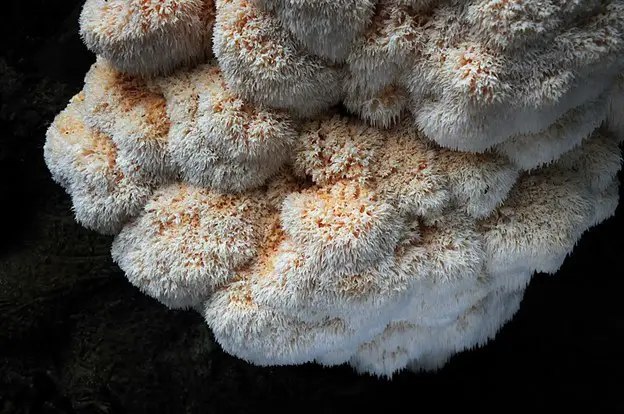
Image Source – https://commons.wikimedia.org/
They are the only class of fungi that can devour both brown lignin and white cellulose at the same rate, leaving behind little more than an earthen brown residue. These particular clean-up artists attack the wood hardwoods.
White rot-causing fungi prefer to grow at a temperature of 65–90 degrees Fahrenheit. Our homes are often that warm, making them an ideal place to grow.
Brown Rot: Brown rot is a type of decay that turns wood brown. It’s true that all wood looks brown already, but upon closer inspection, you will find the fungus makes it much darker. If you can, look at a brown-rotted board. You will see a darker half and a lighter half; it’s really quite easy to see once your eyes adjust to the differences in color. Additionally, brown rotted wood becomes crumbly and cracks into cubical sections. Brown rotting fungi are commonly found in wood from conifer trees.
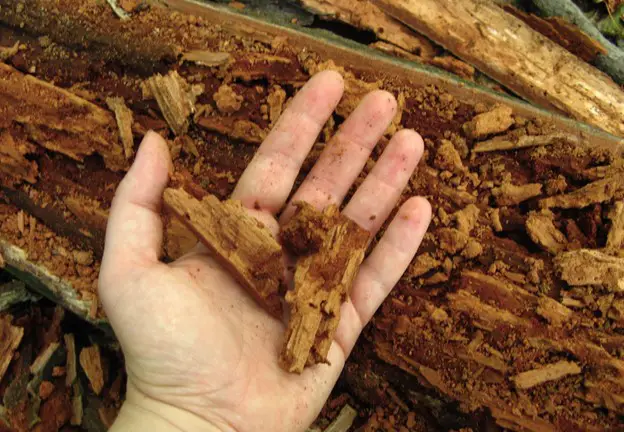
Image Source – Flickr.com
Like the white-rot fungus, brown rot is also a wood-destroying fungus. However, unlike the white variety, brown rot can make its way through or over materials such as plaster and brickwork.
The brown variant of the species only attacks lumber, but if left behind on other materials, it will simply move to and re-infect lumber that has already been repaired. That’s what makes it hard to eliminate.
Check this video to learn more about the fungi species –
Soft Rot: Softwood rotters are a unique type of fungus. They can break down cellulose and lignin, unlike any other fungi.
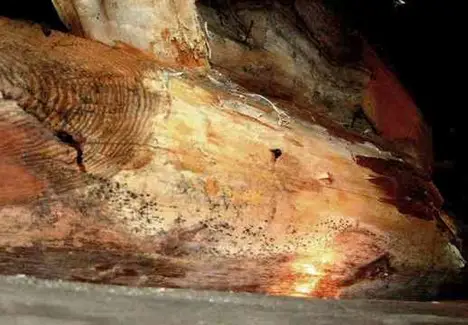
Image Source – https://www.researchgate.net/
The soft rotter begins to grow like a root system, branch after branch. The tubes that are formed by this fungus, combined with the degradation of both cellulose and lignin, make the wood soft.
The good news is that it’s much more common in dead trees than in your home. Besides, soft fungus grows slowly, and they are not as aggressive as white and brown fungi.
The bad news is that soft rot fungus grows best in a much wider range of temperatures. It prefers temperatures between 0 to 110 Fahrenheit. It means that they can grow on your home’s exterior, and they’re more likely to be able to survive in harsher weather conditions.
Wrapping Up
Wood decay fungus is natural and can happen anywhere, but that doesn’t mean you have to let the wood in your home suffer this fate. By taking the time to inspect and treat your wood, you can prevent it from ever fully decaying away; essentially, you can keep your house alive.
Hopefully, my research and tips will help you to rid your home of wood rot and make sure that it doesn’t return.
Source:
https://en.wikipedia.org/wiki/Wood-decay_fungus
https://www.scrt.org/scrt-free-reports/45-wood-decaying-fungi/file
http://ipm.ucanr.edu/PMG/PESTNOTES/pn74109.html
https://www.researchgate.net/


